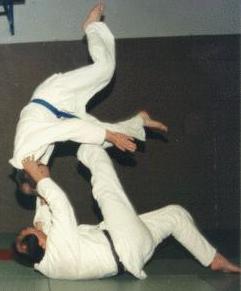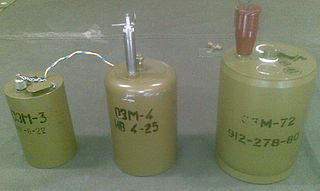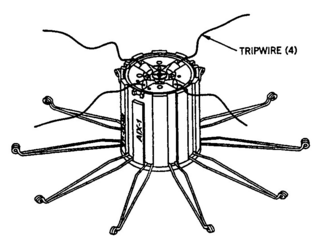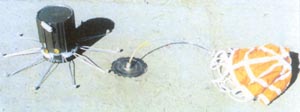
A land mine is an explosive device concealed under or on the ground and designed to destroy or disable enemy targets, ranging from combatants to vehicles and tanks, as they pass over or near it. Such a device is typically detonated automatically by way of pressure when a target steps on it or drives over it, although other detonation mechanisms are also sometimes used. A land mine may cause damage by direct blast effect, by fragments that are thrown by the blast, or by both.

The M18A1 Claymore is a directional anti-personnel mine developed for the United States Armed Forces. Its inventor, Norman MacLeod, named the mine after a large Scottish medieval sword. Unlike a conventional land mine, the Claymore is command-detonated and directional, meaning it is fired by remote-control and shoots a pattern of metal balls into the kill zone like a shotgun. The Claymore can also be victim-activated by booby-trapping it with a tripwire firing system for use in area denial operations.

Scattering is a general physical process where some forms of radiation, such as light, sound, or moving particles, are forced to deviate from a straight trajectory by one or more paths due to localized non-uniformities in the medium through which they pass. In conventional use, this also includes deviation of reflected radiation from the angle predicted by the law of reflection. Reflections that undergo scattering are often called diffuse reflections and unscattered reflections are called specular (mirror-like) reflections.

Open-pit, open-cast or open cut mining is a surface mining technique of extracting rock or minerals from the earth by their removal from an open pit or borrow.

Radio propagation is the behavior of radio waves as they travel, or are propagated, from one point to another, or into various parts of the atmosphere. As a form of electromagnetic radiation, like light waves, radio waves are affected by the phenomena of reflection, refraction, diffraction, absorption, polarization, and scattering. Understanding the effects of varying conditions on radio propagation has many practical applications, from choosing frequencies for international shortwave broadcasters, to designing reliable mobile telephone systems, to radio navigation, to operation of radar systems.

A smoke screen is smoke released to mask the movement or location of military units such as infantry, tanks, aircraft or ships.

In martial arts, a throw is a grappling technique that involves off-balancing or lifting an opponent, and throwing them to the ground, in Japanese martial arts referred to as nage-waza, 投げ技, "throwing technique". Throws usually involve a rotating motion, the practitioner performing the throw disconnects with the opponent, and ends balanced and on their feet as opposed to a takedown where both finish on the ground. Throws can however also be followed into a top position, in which case the person executing the throw does not disengage from the opponent. Certain throwing techniques called sacrifice throws involve putting oneself in a potentially disadvantageous position, such as on the ground, in order to execute a throw.

The GEMSS mine system was a United States mine system, replaced in US service by the Volcano mine system. The mines are deployed from either the towed M128 "Frisbee Flinger" and the M138 "Flipper" portable mine layer.

Anti-personnel mines are a form of mine designed for use against humans, as opposed to anti-tank mines, which are designed for use against vehicles. Anti-personnel mines may be classified into blast mines or fragmentation mines, the latter may or may not be a bouncing mine.

The OZM-3, OZM-4 and OZM-72 are Soviet manufactured bouncing mine type anti-personnel mines.

The AT2 mine is a scatterable anti-tank mine developed by Dynamit Nobel. It can be scattered from artillery rockets or from mine laying systems, and was used by the British, German and Norwegian armed forces until the signing of the Ottawa Treaty.

The VS-50 is a circular plastic cased anti-personnel blast mine, formerly manufactured by the now-defunct Valsella Meccanotecnica SpA, an Italian high-tech defence industry specialized in area denial systems which was also the manufacturer of the Valmara 69 and one of the first industries in the world to implement plastic construction for landmines. The design is similar to the TS-50 and VS-MK2 mine. It is blast resistant and can be used in a minimum metal configuration. Though unlikely to kill, the explosive charge contained within a VS-50 is quite sufficient to destroy the victim's foot: the blast is capable of penetrating 5 mm of mild steel leaving an 80 mm-diameter hole.

Anthoxanthum odoratum, known as sweet vernal grass, is a short-lived perennial grass that is native to acidic grassland in Eurasia. It is grown as a lawn grass and a house plant, due to its sweet scent, and can also be found on unimproved pastures and meadows. The specific epithet odoratum is Latin for 'odorous'.

The POMD-1 is a cylindrical scatterable Bulgarian anti-personnel mine, used in the KNURS-DM 122 mm rocket fired from the BM-21 vehicle mounted rocket launcher. In one 122 mm rocket, a single POMD-1 mine was carried along with 16 PMD-1 AP pressure mines, and four TMD-1 anti-tank mines.
The MATS/2 is a scatterable Italian circular, plastic-cased minimum metal blast resistant anti-tank blast mine. It uses a pneumatic fuse which is resistant to shock and blast similar to the fuse fitted to the TS-50. The mine's plastic case is waterproof, and the mine can be scattered from a helicopter traveling at up to 200 km/h using the Tecnovar DAT dispensing system. A secondary fuse well is provided in the base for the fitting of anti-handling devices.
Beep, Beep is a Warner Bros. cartoon released in 1952 in the Merrie Melodies series featuring Wile E. Coyote and the Road Runner. It was later reissued as a Blue Ribbon cartoon. The cartoon is named after the Road Runner's catchphrase.

The MN-121 is a Polish scatterable anti-tank mine, externally similar to the German AT-2 mine. The mine is cylindrical with ten wire legs which fold outward to keep the mine upright. The mine uses a magnetic influence fuze, which triggers the mine when a vehicle passes over it. The mine also has an anti-handling device which triggers the mine if it is moved. The mine's warhead is a shaped charge design containing approximately 700 grams of RDX. The manufacturer claims that it is capable of penetrating 60 millimeters of armour at an offset of half a meter.
The MN-123 is a Polish scatterable anti-tank mine. The mine is a flat cylinder, with a bevelled edge. It is normally deployed from a ground vehicle, using a dispensing system holding 80 mines. The mine can also be manually laid. Like the MN-121 mine, it uses a magnetic influence fuze which detects when a vehicle passes over it. It also has an anti-handling device. Both faces of the mine have a Misznay Schardin effect shaped charge, which is reportedly able to penetrate 60 millimeters of armour at an offset of 0.3 meters.
The Type 84 is a Chinese air-dispersed scatterable anti-tank mine, normally deployed by the GBL212 122 mm artillery rocket, or the Type 122-15 ATML rocket for export versions. Each rocket can carry six or eight mines and has a range of around six or seven kilometres. The rockets are launched from a BM-21 Grad multiple rocket launcher system that can hold up to 24 of the rockets. A time fuse on the rocket is set before launch, which activates at a predetermined distance after firing. Upon activation, the rocket head bursts, ejecting the mines, which descend with small green parachutes that slow their fall. The mine consists of a cylindrical body with three prong legs that form a spike, which pierces the ground and arms. If the mine strikes soft ground, the spike is driven into the ground and the mine is held upright.

The Fahd is a 4x4 Egyptian armored personnel carrier, designed to fit the requirements of the Egyptian Military. It replaced older APCs in Egyptian service such as the BTR-40, and the Walid. It has been used by eight nations including Egypt, besides being used by the United Nations.















